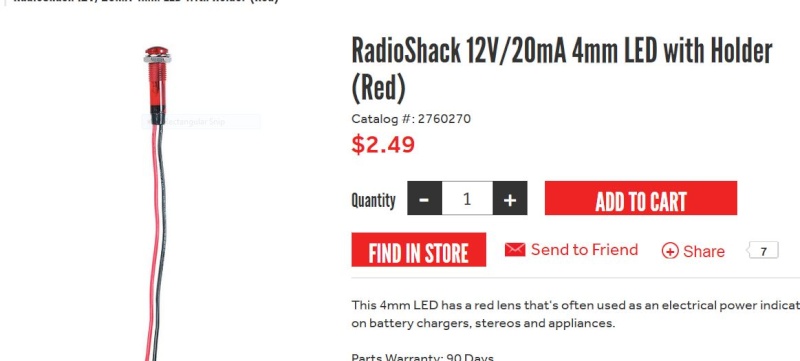1

 Hall effect sensor testing. Wed Mar 30, 2016 9:16 am
Hall effect sensor testing. Wed Mar 30, 2016 9:16 am
Beamer
Platinum member

Hi,
I have been referring to the excellent troubleshooting pdf provided by crazy frog in the portal section.
It shows the connection diagram to test the HES units. Essentially, this uses an LED in series with the open collector output transistor of the Honeywell integrated sensor and amplifier unit. However, the specsheet for the device says output can sink a maximum of 40mA. It is not clear to me how an LED will limit the current to that value.
In view of the price of these things, I don't want to be taking any risks ( without talking about the problems of being without transport until I can be delivered a replacement. ).
Is this test a safe thing to do ?
An LED is not a current limiter like a resistor. It will have a forward voltage drop of about 1.2V when lit up. This means that we need to consider what voltage battery in is being used to test and we should add a suitable series resistor to limit the current to < 40mA.
It is not indicated in the guide but it looks like it is supposed to represent the 12V bike battery.
My calculation:
(12 - 1.2 )V / 40mA = 270 ohm
This means that using less than that value ( eg. no resistance at all , as in the guide ) will likely blow the output transistor. At the very least you're on your own trying it since it would be wildly outside the safe range of operation depending up on what type of battery is used for the test.
I have seen similar schemes proposed on the internet, so I guess at least a few people are doing this kind of thing.
I've also seen articles where the power is connected backwards too, so I'm never sure if some of those writing this stuff have ever actually tries what they writing or whether they actually tested the unit on a bike afterwards.
Is there something I'm missing here, or is this test will a single LED in risk of damaging the unit under test?
TIA.
PS I have just noticed something in the guide. Despite having the electrical symbol for an LED, the label next to it says "12 volt LED".
Now LEDs do not exist as "12V" items. What I suspect this may be referring to is an LED replacement for a 12V dashboard incandescent bulb. I have recently seem a friend who had bought such a plug-in replacement. Obviously, these must have a suitable limiting resistor hidden inside the plastic housing which makes it possible to plug them into a classic bulb holder on a bike.
So my conclusion is that the circuit given in the guide is INCORRECT and will cause people to destroy their expensive HES units if taken as shown.
Crazy frog says up front that he in not an electronic engineer. so probably he did not appreciate the need for a limiting resistor, nor did he realise that "LED" in question is not JUST an LED and that the circuit he provided was not correctly representing what he had used.
He also calls for comments and corrections. So.....
Please specify :
1) Battery voltage in schematic.
2) Add a limiting resistor of at least 270 ohm to the circuit.
3) Add a note explaining that an LED dashboard bulb replacement can be used ( the resistance inside the 276-270 is 680 ohm. ).
The current limiting resistor in these LED units is there for similar reasons and will protect both the LED and the HES.
Sadly my units are already dead thanks to crap info supplied in another guide.
I have been referring to the excellent troubleshooting pdf provided by crazy frog in the portal section.
It shows the connection diagram to test the HES units. Essentially, this uses an LED in series with the open collector output transistor of the Honeywell integrated sensor and amplifier unit. However, the specsheet for the device says output can sink a maximum of 40mA. It is not clear to me how an LED will limit the current to that value.
In view of the price of these things, I don't want to be taking any risks ( without talking about the problems of being without transport until I can be delivered a replacement. ).
Is this test a safe thing to do ?
An LED is not a current limiter like a resistor. It will have a forward voltage drop of about 1.2V when lit up. This means that we need to consider what voltage battery in is being used to test and we should add a suitable series resistor to limit the current to < 40mA.
It is not indicated in the guide but it looks like it is supposed to represent the 12V bike battery.
My calculation:
(12 - 1.2 )V / 40mA = 270 ohm
This means that using less than that value ( eg. no resistance at all , as in the guide ) will likely blow the output transistor. At the very least you're on your own trying it since it would be wildly outside the safe range of operation depending up on what type of battery is used for the test.
I have seen similar schemes proposed on the internet, so I guess at least a few people are doing this kind of thing.
I've also seen articles where the power is connected backwards too, so I'm never sure if some of those writing this stuff have ever actually tries what they writing or whether they actually tested the unit on a bike afterwards.
Is there something I'm missing here, or is this test will a single LED in risk of damaging the unit under test?
TIA.
PS I have just noticed something in the guide. Despite having the electrical symbol for an LED, the label next to it says "12 volt LED".
Now LEDs do not exist as "12V" items. What I suspect this may be referring to is an LED replacement for a 12V dashboard incandescent bulb. I have recently seem a friend who had bought such a plug-in replacement. Obviously, these must have a suitable limiting resistor hidden inside the plastic housing which makes it possible to plug them into a classic bulb holder on a bike.
So my conclusion is that the circuit given in the guide is INCORRECT and will cause people to destroy their expensive HES units if taken as shown.
Crazy frog says up front that he in not an electronic engineer. so probably he did not appreciate the need for a limiting resistor, nor did he realise that "LED" in question is not JUST an LED and that the circuit he provided was not correctly representing what he had used.
He also calls for comments and corrections. So.....
Please specify :
1) Battery voltage in schematic.
2) Add a limiting resistor of at least 270 ohm to the circuit.
3) Add a note explaining that an LED dashboard bulb replacement can be used ( the resistance inside the 276-270 is 680 ohm. ).
The current limiting resistor in these LED units is there for similar reasons and will protect both the LED and the HES.
Sadly my units are already dead thanks to crap info supplied in another guide.
Last edited by Beamer on Wed Mar 30, 2016 4:20 pm; edited 1 time in total
















 1986 k75, 1985 K100rt,
1986 k75, 1985 K100rt, 


